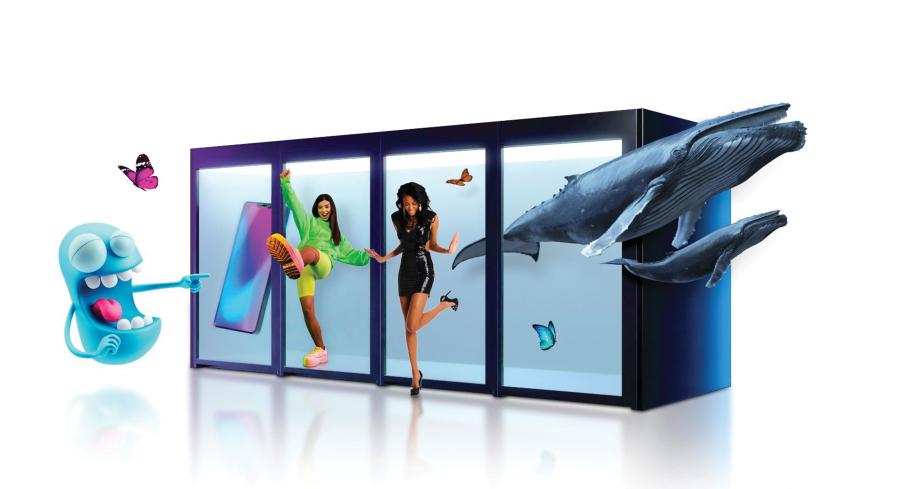Designers and storytellers have long used “holograms” inside attractions in the attempt to amaze visitors. Yet, strictly speaking, attractions have not yet actually presented true holograms the way audiences have seen them in futuristic scenes from fictional series like “Star Trek” and “Star Wars.”
Superimposed images, augmented reality (AR), and mirrored projections are just some of the methods used to give the impression of 3D. Often, screens and 3D eyewear are usually involved, which wouldn’t be necessary with a true hologram. To date, projections of light needed to reflect off some surface to be visible, as the images aren’t visible in empty air...until now.
A newly developed, cutting-edge holographic technology that—pardon the pun—has introduced a whole new dimension to 3D. It’s named Miirage, and to anyone viewing the system, a person, animal, or object not only appears completely three-dimensional, but also seems to be moving around in a three-dimensional space, visible to the naked eye. Better still, it doesn’t have to be in a dark environment and can be seen in normal lighting conditions or full daylight.
“It’s so bright that the image carries across incredibly well, and ambient lighting is ideal,” James Butler, founder and CEO of London-headquartered Miirage, explains to Funworld. “The technology merges the physical and virtual worlds by utilizing transparent LCDs to create holographic illusions. It takes people, objects, products, and characters, and makes them look as if they are actually moving in front of us in life-like resolution.”
Chief Customer Officer for Miirage, Mark Lister, says one significant way the system distinguishes itself is through open panoramic viewing, where the beholder needs no eyewear or other devices.
“With virtual reality, it’s a solitary experience. But Miirage allows you to share it with your family and others around you, which is what storytellers want,” Lister explains.
Developing A New Technique
Butler and Lister say much of their background is rooted in the events industry. When COVID-19 emerged, the pair was planning a tour of Thailand with a client who had hoped to present the holograms of celebrities at shopping malls.
However, most of the available technology relied on projection technology, which wouldn’t work in brightly lit venues. To address the challenge, James, an expert in holograms, created the new technology while residing in Macau during the COVID-19 lockdowns.
“He designed Miirage towards the global events and attractions industry,” says Lister. “It’s modular, so you can just keep adding units to grow it. It’s also scalable and easy to transport. There’s nothing else like it currently in the global marketplace.” He adds that Miirage can be used as part of a large ride or other immersive attraction, as a stand-alone experience, or to enhance live entertainment.
To heighten the illusion, Lister says the content needs to keep moving, even if the movement is subtle. The viewing “sweet spot” is three to seven meters away, but because of its brightness and high-resolution, the images appear life-like even close up.
“A park attraction is really a perfect place for it because you can build sets around it—an environment with foliage, etc.—and people stay in front of it,” says Lister.
First Application of the Innovation
Beyond theme parks, the technology can be applied in museums, science centers, zoos, and aquariums, where modular units can be used in educational settings.
Lister also foresees a live-streaming application, where a telepresence can save on carbon emissions where an executive could deliver a speech in a 3D format, thus preventing the need to step foot on an airplane.
Since the technology is so new, Lister admits Miirage has faced challenges demonstrating the innovation through static photos or 2D video.
“Because people haven’t seen anything quite like it...they won’t completely ‘get it’ until they see it. The critical factor to understand is that it’s the depth that [makes] the illusion. We’ve had success doing remote demo webinars where we are in front of Miirage answering questions, calling up content by use case and showing off its dimensions and viewing angles,” Lister says.
He asserts that attractions are the ideal domain for a technology like Miirage because the technology can be used for entertainment, wayfinding, or advertising. Also, guests can experience it, then return two months later and the application can be a different experience.
There are already Miirage systems operating in London, Hong Kong, and Melbourne, with more on the way as this advancing 3D hologram technology gains attention.



